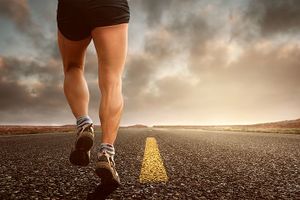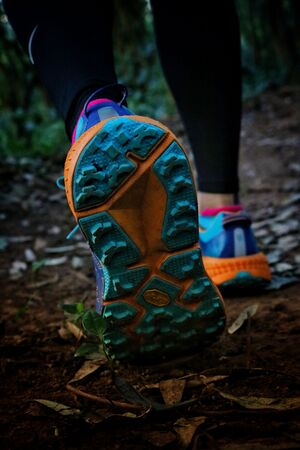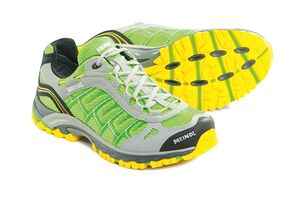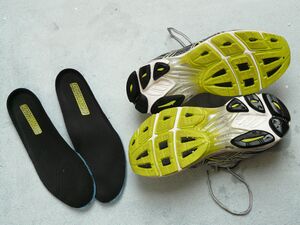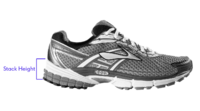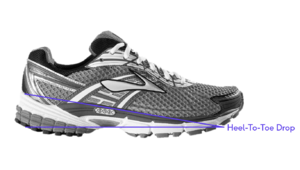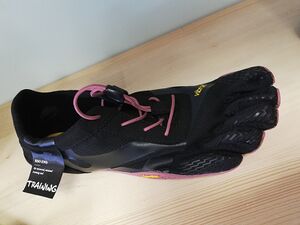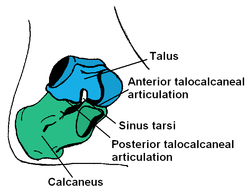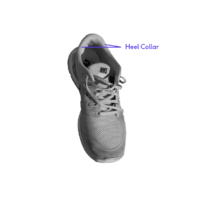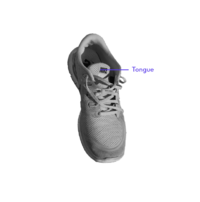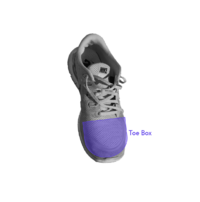Shoe Analysis - Basic Anatomy of a Running Shoe: Difference between revisions
(added categories) |
(added short sentence to intro and recent reference) |
||
| (29 intermediate revisions by 4 users not shown) | |||
| Line 1: | Line 1: | ||
<div class="editorbox"> '''Original Editor '''- [https://members.physio-pedia.com/course_tutor/dawn-nunes/ Dawn Nunes] '''Top Contributors''' - {{Special:Contributors/{{FULLPAGENAME}}}}</div> | <div class="editorbox"> '''Original Editor '''- [https://members.physio-pedia.com/course_tutor/dawn-nunes/ Dawn Nunes] '''Top Contributors''' - {{Special:Contributors/{{FULLPAGENAME}}}}</div> | ||
== Introduction == | == Introduction == | ||
[[File:Runner surface and shoes.jpg|thumb]] | [[File:Runner surface and shoes.jpg|thumb]] | ||
There is a considerable range of running shoes available on the market. There are multiple brands, styles and colours, as well as various shoes for specific types of running (e.g. road, trail, or track). With runners striving to increase performance and reduce the risk of injuries, the footwear market has bloomed and along with it the technological advancement of running shoes.<ref>Andreyo E, Unverzagt C, Schoenfeld BJ. Influence of Minimalist Footwear on Running Performance and Injury. Strength and Conditioning Journal. 2022 Jun 26;44(3):107-16.</ref> It is vital to understand the makeup of a running shoe and the specific needs of the [[An Introduction to Understanding Your Runner|runner]] - what would best suit them for their training and racing? Runners may even need more than one shoe if they train on both trail and road or require different types of trail shoes for different terrains. | |||
Not only is there a large selection of shoes to choose from, there has been an enormous change in shoe design over the past 100 years. | |||
== Research on Running Shoes == | |||
[[File:Running shoe.jpg|thumb|Trail running shoe outer sole]]Running shoes are engineered specifically for their intended purpose. They are described using terms such as support, cushioning, lightweight, minimalist and barefoot.<ref name=":2">Nigg BM, Baltich J, Hoerzer S, Enders H. [https://bjsm.bmj.com/content/bjsports/49/20/1290.full.pdf Running shoes and running injuries: mythbusting and a proposal for two new paradigms:‘preferred movement path’ and ‘comfort filter’]. British journal of sports medicine. 2015 Oct 1;49(20):1290-4</ref> A basic understanding of their structure is necessary to effectively assess, treat and recommend shoes to runners.<ref name=":1" /> | |||
* Running shoes play a vital role in the [[biomechanics]] and running economy of runners: | |||
** Vercruyssen et al.<ref name=":0">Vercruyssen F, Tartaruga M, Horvais N, Brisswalter J. [https://journals.lww.com/acsm-msse/Fulltext/2016/10000/Effects_of_Footwear_and_Fatigue_on_Running_Economy.15.aspx Effects of footwear and fatigue on running economy and biomechanics in trail runners]. Med Sci Sports Exerc. 2016 Oct 1;48(10):1976-84</ref> found that [[Calf Strain|calf pain]] increased significantly in trail runners who wore a minimalist shoe compared with trail runners who wore a traditional shoe. | |||
* Motion control (supported or anti-pronation) shoes should be considered when choosing/selecting a shoe for a runner. | |||
** One study<ref>Cheung RT, Ng GY. [https://academic.oup.com/ptj/article/88/5/620/2742415 Influence of different footwear on force of landing during running]. Phys Ther. 2008;88(5):620-8. </ref> found that the plantar force over the medial [[Ankle and Foot|foot]] structures increased as running mileage/distance increased in recreational runners wearing neutral shoes, but not in those wearing motion control shoes. Runners in this study had 6 or more degrees of foot pronation. | |||
* Altering the material hardness of the midsole can affect muscle activation in response to the loading rate of the impact forces at heel-strike.<ref>Wakeling JM, Pascual SA, Nigg BM. [https://journals.lww.com/acsm-msse/Fulltext/2002/09000/Altering_muscle_activity_in_the_lower_extremities.21.aspx Altering muscle activity in the lower extremities by running with different shoes]. Medicine and science in sports and exercise. 2002 Sep 10;34(9):1529-32</ref> | |||
* The weight of the running shoe can affect biomechanics. | |||
** Wang et al.<ref name=":6">Wang IL, Graham RB, Bourdon EJ, Chen YM, Gu CY, Wang LI. [https://www.ncbi.nlm.nih.gov/pmc/articles/PMC7039018/pdf/jssm-19-130.pdf Biomechanical analysis of running foot strike in shoes of different mass]. Journal of sports science & medicine. 2020 Mar;19(1):130</ref> showed that the peak vertical ground reaction force increased significantly as shoe mass increased, which may heighten injury risk. | |||
** While every individual has their own running strategy, the running shoe's mass may cause an alteration in strike pattern and the coordination of the running strategy.<ref name=":6" /> | |||
* Two paradigms have been proposed by Nigg et al.<ref name=":2" /> | |||
** Preferred movement path - an individual athlete's skeleton attempts to stay in the same movement path for a given task (e.g. heel-toe running) | |||
** Comfort filter - the comfort level of the shoe which the runner selects is due to the runner’s own comfort filter. This comfort filter automatically reduces the risk of injury and may explain why there is no clear trend in the number of running injuries over time.<ref name=":2" /> | |||
* Comparison of three different styles of shoes (minimalist; cushioned and large heel-toe drop)<ref name=":3">Hoitz F, Vienneau J, Nigg BM. [https://journals.plos.org/plosone/article?id=10.1371/journal.pone.0239852 Influence of running shoes on muscle activity]. PloS one. 2020 Oct 7;15(10):e0239852.</ref>: | |||
** Large adaptations in muscle activation are needed when running conditions are drastically different – for example, changing from a minimalist to a cushioned or extreme heel-toe drop. | |||
** The movement path can be maintained with small changes in muscle activation when running conditions are similar, including using similar shoes. | |||
Research, therefore, shows the importance of knowing your running shoe to fit your runner and the impact that shoes can have on muscle activation. It also highlights that the comfort level of a shoe may have a significant influence on injury risk. | |||
== Importance of Shoe Anatomy == | == Importance of Shoe Anatomy == | ||
| Line 29: | Line 32: | ||
** Be specific for each runner | ** Be specific for each runner | ||
** Understand the goals of the runner | ** Understand the goals of the runner | ||
** What are their aims and what do they want to achieve | ** What are their aims and what do they want to achieve? | ||
These factors will play an integral role | These factors will play an integral role in determining what type of shoe should be recommended. | ||
More information available here: [https://members.physio-pedia.com/learn/an-introduction-to-understanding-your-runner/ Introduction to | More information is available here: [https://members.physio-pedia.com/learn/an-introduction-to-understanding-your-runner/ Introduction to Understanding Your Runner]; [https://members.physio-pedia.com/learn/subjective-assessment-of-a-runner/ Subjective Assessment of a Runner] | ||
* Finding the right fit | * Finding the right fit | ||
| Line 39: | Line 42: | ||
*** The runner’s anatomy | *** The runner’s anatomy | ||
*** The shape of the [[Ankle and Foot|foot]] | *** The shape of the [[Ankle and Foot|foot]] | ||
*** Pre-existing or previous conditions – certain shoes may assist in supporting certain structures and | *** Pre-existing or previous conditions – certain shoes may assist in supporting certain structures and prevent the irritation of other conditions | ||
* | * Shoes must fit correctly | ||
** | ** To prevent blisters | ||
** | ** To maintain good circulation | ||
** | ** To prevent tightness especially as feet swell | ||
** | ** To prevent pins and needles (paraesthesia) | ||
** | ** To ensure shoes are comfortable to wear | ||
It is important to know | It is important to know what type of surface the runner is predominantly running on: road, trail, or track? Does the runner need one versatile shoe for both road and trail? Is your runner wanting to have different pairs of shoes for road running and trail running? Also, consider the affordability of this. | ||
== Fit the Shoe Correctly == | == Fit the Shoe Correctly == | ||
These are guidelines but need to be adapted for each individual runner. | These are guidelines, but they need to be adapted for each individual runner. | ||
* Ideally fit a shoe at the end of the day. | * Ideally fit a shoe at the end of the day. | ||
* Put the shoe on | * Put the shoe on, then test while standing to see that there is a finger space in the front to allow room for the toes. | ||
* Walk in the shoe and determine comfort. | * Walk in the shoe and determine comfort. | ||
* Ensure that the heel doesn’t slide up. | * Ensure that the heel doesn’t slide up. | ||
* Check the lacing - lace the shoe as normal to get an accurate feel of the shoe. | * Check the lacing - lace the shoe as normal to get an accurate feel of the shoe. | ||
* Proper fitting of the shoe may prevent blisters. | * Proper fitting of the shoe may prevent blisters. | ||
* The running shoe must not be too tight – allow for feet to swell | * The running shoe must not be too tight – allow for feet to swell. This is especially important for ultra runners who spend a long period in their shoes. | ||
* Some trail runners, in particular, prefer a more snug fit, especially for technical terrain. This comes down to what has worked for the | * Some trail runners, in particular, prefer a more snug fit, especially for technical terrain. This comes down to what has worked for the runner and their personal preference. | ||
* If the shoe is too tight it could possibly cause circulation problems or even pins and needles (paraesthesia). | * If the shoe is too tight it could possibly cause circulation problems or even pins and needles (paraesthesia). | ||
* The way the shoe is laced may also have an impact on the above, even if a correct size shoe is worn. | * The way the shoe is laced may also have an impact on the above, even if a correct size shoe is worn. | ||
''These guidelines will help you fit the shoe well, understand the shoe and be able to have the knowledge to guide runners into which shoe may be the best for them.'' | ''These guidelines will help you fit the shoe well, understand the shoe and be able to have the knowledge to guide runners into which shoe may be the best for them.''<ref name=":1">Nunes, D. Shoe Analysis-Shoe Anatomy Course. Plus. 2021</ref> | ||
== Road Running Shoes | == Road Running Shoes versus Trail Running Shoes == | ||
[[File:Trail running shoes.jpg|thumb| | [[File:Trail running shoes.jpg|thumb|Trail running shoes with lugs on the outer sole|alt=]] | ||
Road running shoes and trail running shoes look different. The main difference is the outer soles | Road running shoes and trail running shoes look different. The main difference is the outer soles: trail running shoes have lugs (deep indentations in a pattern designed to provide good footing) and road running shoes are smooth. There are many different types of road and trail shoes. Trail shoes can have varied lugs: | ||
* Large and spaced out | * Large and spaced out lugs | ||
* Smaller lugs with more | * Smaller lugs - with more lugs on the outer sole | ||
* Large, deep | * Large, deep lugs that are fairly dense | ||
Different lugs have different functions. Shoes with deeper lugs are suitable for muddy terrain - they help to prevent mud from getting stuck between lugs. Because they have a larger surface area, these shoes are better able to grip. Shoes with a smaller and greater number of lugs are used for more technical trails. They are more likely to be more comfortable over longer distances. | |||
[[File:Road running shoes.jpg|thumb|Road running shoes]] | [[File:Road running shoes.jpg|thumb|Road running shoes]] | ||
The road running shoe is flat underneath with no lugs as | The road running shoe is flat underneath with no lugs as grip is not really needed. However, road running shoes vary in cushioning depending on the function or the runner's preference. | ||
If a runner prefers to have just one shoe for trail and road, it is best to recommend a trail shoe with smaller lugs. Be aware that the lugs will most likely wear out quicker with road running than with trail running and this should be taken into consideration. | |||
The upper part of the shoe is also specifically designed for road or trail. The uppers of trail shoes vary but tend to be firmer to sustain the harsh terrain without ripping, | The upper part of the shoe is also specifically designed for road or trail. The uppers of trail shoes vary, but tend to be firmer to sustain the harsh terrain without ripping. However, they still need to be breathable. Trail shoes will often have a firmer part at the front of the shoe. | ||
{{#ev:youtube|M_muUYjoVcQ|300}}<ref>REI. What's the difference between trail and road shoes. Available from https://www.youtube.com/watch?v=M_muUYjoVcQ. (last accessed 12 October 2021)</ref> | {{#ev:youtube|M_muUYjoVcQ|300}}<ref>REI. What's the difference between trail and road shoes. Available from https://www.youtube.com/watch?v=M_muUYjoVcQ. (last accessed 12 October 2021)</ref> | ||
== Important Aspects in Selecting Running Shoes == | == Important Aspects in Selecting Running Shoes == | ||
==== Stack | ==== Stack Height / Cushioning ==== | ||
[[File:Stack Height.png|thumb|Stack height of running shoe|alt=|200x200px]] | [[File:Stack Height.png|thumb|Stack height of running shoe|alt=|200x200px]] | ||
The cushioning of a shoe decreases the impact on | The cushioning of a shoe decreases the impact on a runner's feet between the shoe and the surface area (road/ trail). It is recommended to have more cushioning for longer runs, so that the feet are more comfortable and cushioned. The midsole thickness can change how and for how long the runner contacts the ground. Furthermore, the distribution of sole thickness from under the heel and toe affects running motion.<ref>Vincent HK, Vincent KR. Considerations in the Selection of a Running Shoe. InClinical Care of the Runner 2020 Jan 1 (pp. 95-99). Elsevier.</ref> | ||
{{#ev:youtube|H-BeMkQC-Xg|300}}<ref>Average Running PT. Running shoe features: Part 1. Stack Height in Running Shoes. Available from https://www.youtube.com/watch?v=H-BeMkQC-Xg. (last accessed 12 October 2021)</ref> | {{#ev:youtube|H-BeMkQC-Xg|300}}<ref>Average Running PT. Running shoe features: Part 1. Stack Height in Running Shoes. Available from https://www.youtube.com/watch?v=H-BeMkQC-Xg. (last accessed 12 October 2021)</ref> | ||
==== Heel to Toe Drop/ Heel Drop ==== | ==== Heel to Toe Drop / Heel Drop ==== | ||
[[File:Heel to toe drop.png|thumb|Heel to toe drop]] | [[File:Heel to toe drop.png|thumb|Heel to toe drop]] | ||
Heel to toe drop refers to the difference in height between the heel and the toe of the shoe. There is usually a drop of between 0 and 11mm: | |||
* 0mm is a minimalist heel drop | |||
* 5mm is a middle heel drop | |||
* 11mm is the maximal heel drop | |||
It is possible to have a shoe with a large cushioning, but a minimalistic (0mm) heel drop. In other words, the shoe is flat (similar to being barefoot), but it is cushioned. You can also get a cushioned shoe with a heel-toe drop of 5 or 10mm. | |||
There are also shoes with minimal cushioning and low heel-toe drop - which is a minimalistic shoe (i.e. barefoot running) - or shoes with minimal cushioning that have a high heel drop of 5 to 10mm. | |||
{{#ev:youtube|watch?v=Azng4C0PGnM&t=156s|300}}<ref>RunRepeat.com. The Ultimate Guide to Heel to Toe Drop. Available from https://www.youtube.com/watch?v=Azng4C0PGnM&t=156s. (last accessed 13 October 2021) </ref> | {{#ev:youtube|watch?v=Azng4C0PGnM&t=156s|300}}<ref>RunRepeat.com. The Ultimate Guide to Heel to Toe Drop. Available from https://www.youtube.com/watch?v=Azng4C0PGnM&t=156s. (last accessed 13 October 2021) </ref> | ||
==== Flexibility ==== | ==== Flexibility ==== | ||
[[File:Minimalist shoe example.jpeg|thumb|Example of a minimalist shoe ]] | |||
Two ways to easily test the flexibility of running shoes are: | Two ways to easily test the flexibility of running shoes are: | ||
# Flex the toe part of the shoe upwards to test the flexibility of the sole – mimicking toe-off. | # Flex the toe part of the shoe upwards to test the flexibility of the sole – mimicking toe-off. | ||
# Torsional test - | # Torsional test - check how easy it is to twist the shoe. Is there any resistance offered? How much does the shoe twist? | ||
By testing flexibility, it is possible to see what kind of support the shoe may offer. If there is a large play, or movement, in either or both movements, the shoe is probably not going to be very supportive. However, if there is a bit of resistance and less movement, more support will be available. | |||
{{#ev:youtube|watch?v=RppddH-hBz4|300}}<ref>Lucky Feet Shoes. 3 types of Running Shoes- Motion Control, Stability & Neutral. Available from https://www.youtube.com/watch?v=RppddH-hBz4. (last accessed 13 October 2021)</ref> | {{#ev:youtube|watch?v=RppddH-hBz4|300}}<ref>Lucky Feet Shoes. 3 types of Running Shoes- Motion Control, Stability & Neutral. Available from https://www.youtube.com/watch?v=RppddH-hBz4. (last accessed 13 October 2021)</ref> | ||
==== | ==== Supported Shoes ==== | ||
[[File:SubtalarJoint.PNG|thumb|Subtalar joint]] | |||
Supported shoes are also known as anti-pronation shoes <ref>Jafarnezhadgero A, Alavi-Mehr SM, Granacher U. [https://journals.plos.org/plosone/article?id=10.1371/journal.pone.0216818 Effects of anti-pronation shoes on lower limb kinematics and kinetics in female runners with pronated feet: The role of physical fatigue]. PloS one. 2019 May 14;14(5):e0216818.</ref> although this name is becoming less popular. A firmer base is made on the inner part (medial side) of the shoe to provide the additional support to prevent the over-pronation movement.<ref>Lilley K, Stiles V, Dixon S. [https://journals.sagepub.com/doi/full/10.1177/1754337120984619 The influence of design variations in footwear medial-lateral support on the running biomechanics of older female runners.] Proceedings of the Institution of Mechanical Engineers, Part P: Journal of Sports Engineering and Technology. 2021 Jan 14:1754337120984619.</ref> Pronation is defined as the inward rotation of the rear foot about the subtalar joint axis. Supination is the outward rotation of the rear foot about the subtalar joint axis.<ref>Nigg B, Behling AV, Hamill J. Foot pronation. Footwear Science. 2019 Sep 2;11(3):131-4.</ref> If the runner has a supported shoe and it works for them, keep it. If, when they changed to a supported shoe they started to develop an injury, this may be a possible cause to keep in mind.<ref name=":1" /> | |||
If the runner has not got a supported shoe and some additional support may be needed, opt for a neutral shoe and consult/refer to an orthotist/podiatrist to create the necessary [[Introduction to Orthotics]] i.e. the amount to build up, as well as the exact area of support.<ref name=":1" /> | |||
===== Difference Between Running Shoes ===== | |||
* Neutral shoes | |||
** Running shoes that are generally lightweight and flexible, with no specific features to address overpronation<ref name=":5">Nike.com. [https://www.nike.com/za/a/stability-vs-motion-control-running-shoes What's the Difference Between Stability and Motion Control Running Shoes?] Available from https://www.nike.com/za/a/stability-vs-motion-control-running-shoes (accessed 2 November 2021)</ref> | |||
* Stability or supported shoes | |||
** These shoes are designed to support the arch of the foot. There is greater support through the midsole and this support may extend into the heel. Shoes are slightly stiffer and heavier than a neutral shoe.<ref name=":5" /> | |||
* Motion control shoes | |||
** These shoes provide arch support in the midsole, but usually also have additional heel cup support and other features to stop the foot from rolling during each step. Shoes are stiffer and heavier than neural or stability shoes. These shoes are often designed for runners with flat feet or those with severe overpronation.<ref name=":5" /> | |||
{{#ev:youtube|/watch?v=IKfHtVbkgLk|300}}<ref>Running Physio. Are motion control shoes the answer for pronation related injuries? Available from https://www.youtube.com/watch?v=IKfHtVbkgLk. (last accessed 13 October 2021)</ref> | {{#ev:youtube|/watch?v=IKfHtVbkgLk|300}}<ref>Running Physio. Are motion control shoes the answer for pronation related injuries? Available from https://www.youtube.com/watch?v=IKfHtVbkgLk. (last accessed 13 October 2021)</ref> | ||
| Line 117: | Line 135: | ||
* Heel collar | * Heel collar | ||
** Assess if there is any asymmetry | ** Assess if there is any asymmetry - if the collar bends inwards, it may indicate pronation | ||
** | ** Using video analysis can help to identify if the runner has forefoot or rearfoot pronation or a combination. | ||
* [[File:Shoe Tongue.png|thumb|Tongue of the shoe|alt=|202x202px]]Identify the tongue of the shoe | * [[File:Shoe Tongue.png|thumb|Tongue of the shoe|alt=|202x202px]]Identify the tongue of the shoe | ||
* Upper | * Upper | ||
** What is it made of? For example, mesh and how dense? | ** What is it made of? For example, mesh and how dense? | ||
** | ** Trail shoes have a toe bumper - i.e. a solid part to protect the toes from being hit by rocks. | ||
** What is the wear on the upper? This might indicate where a runner scuffs one leg on the other. | ** What is the wear on the upper? This might indicate where a runner scuffs one leg on the other. | ||
* [[File:Toe Box.png|thumb|Toe box|alt=|202x202px]]Toe box | * [[File:Toe Box.png|thumb|Toe box|alt=|202x202px]]Toe box | ||
** | ** This is an important aspect of the shoe | ||
** | ** There are different sizes available in the same make shoe, so it is necessary to check that the runner has what they need. | ||
** | *** Are their toes bulging out the sides or is the toe box loose with too much space? | ||
** How wide or narrow is the toe box and does it fit well? | *** How wide or narrow is the toe box and does it fit well? | ||
* Lacing | * Lacing | ||
** Note how the runner laces their shoe. This may have an influence on possible niggles or injuries developing. | ** Note how the runner laces their shoe. This may have an influence on possible niggles or injuries developing. | ||
** The shoe can be laced differently to accommodate areas that need either more or less support. | ** The shoe can be laced differently to accommodate areas that need either more or less support. | ||
** Lock laces are also an option but depend on personal preference. The lock lace is great in that once it is in place, you won’t have to stop and tie a shoelace! | ** Lock laces are also an option, but depend on personal preference. The lock lace is great in that once it is in place, you won’t have to stop and tie a shoelace! | ||
==== Lacing | ==== Lacing techniques ==== | ||
Read more about lacing techniques in this blog post by RunRepeat: [https://runrepeat.com/top-10-running-shoe-lacing-techniques The top 12 shoe lacing techniques]. | Read more about lacing techniques in this blog post by RunRepeat: [https://runrepeat.com/top-10-running-shoe-lacing-techniques The top 12 shoe lacing techniques]. The image below is a useful guide to these 12 lacing techniques. The videos below also show how to perform the different lacing techniques. | ||
[[File:How-to-lace-your-shoes.jpg|center|thumb|400x400px|How to lace your shoes (image from [https://runrepeat.com/top-10-running-shoe-lacing-techniques RunRepeat])]] | |||
<div class="row"> | <div class="row"> | ||
<div class="col-md-3"> {{#ev:youtube|watch?v=S4mwjpFOjJc&list=PLL-rh1VZDnMTUPkEqMx1BRkmcA1yaA7Vw&index=1|250}} <div class="text-right"><ref>RunRepeat.com.Flat feet lacing technique by RunRepeat.com. Available from https://www.youtube.com/watch?v=S4mwjpFOjJc&list=PLL-rh1VZDnMTUPkEqMx1BRkmcA1yaA7Vw&index=1. (last accessed 13 October 2021) </ref></div></div> | <div class="col-md-3"> {{#ev:youtube|watch?v=S4mwjpFOjJc&list=PLL-rh1VZDnMTUPkEqMx1BRkmcA1yaA7Vw&index=1|250}} <div class="text-right"><ref>RunRepeat.com.Flat feet lacing technique by RunRepeat.com. Available from https://www.youtube.com/watch?v=S4mwjpFOjJc&list=PLL-rh1VZDnMTUPkEqMx1BRkmcA1yaA7Vw&index=1. (last accessed 13 October 2021) </ref></div></div> | ||
| Line 166: | Line 185: | ||
== Race versus Training Running Shoes == | == Race versus Training Running Shoes == | ||
There are a variety of brands and within each brand, there are different types of shoes. Trail, road, track, and a combination of these. It is important to note if the runner, in particular road runners, likes to use a racing shoe and a training shoe. In general, the racing shoe is lighter – so the overall weight of the shoe is less | There are a variety of brands and within each brand, there are different types of shoes. Trail, road, track, and a combination of these. It is important to note if the runner, in particular road runners, likes to use a racing shoe and a training shoe. In general, the racing shoe is lighter – so the overall weight of the shoe is less. Its material, particularly the cushioning, is made of extremely good material, but it may not last long due to impact, so these shoes have a shorter run life. Training shoes may be more cushioned and possibly more stable – longer time in the shoe for comfort and longevity.<ref name=":1" /> | ||
=== Different Brands === | === Different Brands === | ||
Different brands may be known for specific aspects of a shoe | Different brands may be known for specific aspects of a shoe. Some may have a narrower fit while other brands may offer different toe box sizes. Ultimately, if the runner comes with a specific brand and it works for them, don’t change it unless necessary. Look at [[An Introduction to Understanding Your Runner]] and [[Subjective Assessment of a Runner]] for more information on how to be specific in analysing the runner and their needs. | ||
=== Vary Shoes === | === Vary Shoes === | ||
If possible, it is recommended | If possible, it is recommended that a runner has two pairs of shoes that they can swap between while training. It can even be the same make, worn at different times. This allows the runner's feet to experience a different feel and adapt to this, rather than being in the same shoe all the time. Malisoux et al.<ref name=":4">Malisoux L, Ramesh J, Mann R, Seil R, Urhausen A, Theisen D. Can parallel use of different running shoes decrease running‐related injury risk?. Scandinavian journal of medicine & science in sports. 2015 Feb;25(1):110-5.</ref> showed that runners who use more than one pair of running shoes at the same time had a lower risk of running-related injuries. It is hypothesised that alternating between running shoes induces a variation in the physical load applied to the musculoskeletal system.<ref name=":4" /> | ||
'''''Ensure that you recommend the shoe that suits the | '''''Ensure that you recommend the shoe that suits the runner's needs, abilities and terrain, and NOT the looks!''''' | ||
== Resources == | == Resources == | ||
| Line 182: | Line 201: | ||
<references /> | <references /> | ||
[[Category:Course Pages]] | [[Category:Course Pages]] | ||
[[Category: | [[Category:Plus Content]] | ||
[[Category:Sports Medicine]] | [[Category:Sports Medicine]] | ||
[[Category:Running]] | [[Category:Running]] | ||
Latest revision as of 20:29, 11 January 2023
Introduction[edit | edit source]
There is a considerable range of running shoes available on the market. There are multiple brands, styles and colours, as well as various shoes for specific types of running (e.g. road, trail, or track). With runners striving to increase performance and reduce the risk of injuries, the footwear market has bloomed and along with it the technological advancement of running shoes.[1] It is vital to understand the makeup of a running shoe and the specific needs of the runner - what would best suit them for their training and racing? Runners may even need more than one shoe if they train on both trail and road or require different types of trail shoes for different terrains.
Not only is there a large selection of shoes to choose from, there has been an enormous change in shoe design over the past 100 years.
Research on Running Shoes[edit | edit source]
Running shoes are engineered specifically for their intended purpose. They are described using terms such as support, cushioning, lightweight, minimalist and barefoot.[2] A basic understanding of their structure is necessary to effectively assess, treat and recommend shoes to runners.[3]
- Running shoes play a vital role in the biomechanics and running economy of runners:
- Motion control (supported or anti-pronation) shoes should be considered when choosing/selecting a shoe for a runner.
- Altering the material hardness of the midsole can affect muscle activation in response to the loading rate of the impact forces at heel-strike.[6]
- The weight of the running shoe can affect biomechanics.
- Wang et al.[7] showed that the peak vertical ground reaction force increased significantly as shoe mass increased, which may heighten injury risk.
- While every individual has their own running strategy, the running shoe's mass may cause an alteration in strike pattern and the coordination of the running strategy.[7]
- Two paradigms have been proposed by Nigg et al.[2]
- Preferred movement path - an individual athlete's skeleton attempts to stay in the same movement path for a given task (e.g. heel-toe running)
- Comfort filter - the comfort level of the shoe which the runner selects is due to the runner’s own comfort filter. This comfort filter automatically reduces the risk of injury and may explain why there is no clear trend in the number of running injuries over time.[2]
- Comparison of three different styles of shoes (minimalist; cushioned and large heel-toe drop)[8]:
- Large adaptations in muscle activation are needed when running conditions are drastically different – for example, changing from a minimalist to a cushioned or extreme heel-toe drop.
- The movement path can be maintained with small changes in muscle activation when running conditions are similar, including using similar shoes.
Research, therefore, shows the importance of knowing your running shoe to fit your runner and the impact that shoes can have on muscle activation. It also highlights that the comfort level of a shoe may have a significant influence on injury risk.
Importance of Shoe Anatomy[edit | edit source]
- Variety and significance
- Be specific for each runner
- Understand the goals of the runner
- What are their aims and what do they want to achieve?
These factors will play an integral role in determining what type of shoe should be recommended.
More information is available here: Introduction to Understanding Your Runner; Subjective Assessment of a Runner
- Finding the right fit
- Consider the following:
- The runner’s anatomy
- The shape of the foot
- Pre-existing or previous conditions – certain shoes may assist in supporting certain structures and prevent the irritation of other conditions
- Consider the following:
- Shoes must fit correctly
- To prevent blisters
- To maintain good circulation
- To prevent tightness especially as feet swell
- To prevent pins and needles (paraesthesia)
- To ensure shoes are comfortable to wear
It is important to know what type of surface the runner is predominantly running on: road, trail, or track? Does the runner need one versatile shoe for both road and trail? Is your runner wanting to have different pairs of shoes for road running and trail running? Also, consider the affordability of this.
Fit the Shoe Correctly[edit | edit source]
These are guidelines, but they need to be adapted for each individual runner.
- Ideally fit a shoe at the end of the day.
- Put the shoe on, then test while standing to see that there is a finger space in the front to allow room for the toes.
- Walk in the shoe and determine comfort.
- Ensure that the heel doesn’t slide up.
- Check the lacing - lace the shoe as normal to get an accurate feel of the shoe.
- Proper fitting of the shoe may prevent blisters.
- The running shoe must not be too tight – allow for feet to swell. This is especially important for ultra runners who spend a long period in their shoes.
- Some trail runners, in particular, prefer a more snug fit, especially for technical terrain. This comes down to what has worked for the runner and their personal preference.
- If the shoe is too tight it could possibly cause circulation problems or even pins and needles (paraesthesia).
- The way the shoe is laced may also have an impact on the above, even if a correct size shoe is worn.
These guidelines will help you fit the shoe well, understand the shoe and be able to have the knowledge to guide runners into which shoe may be the best for them.[3]
Road Running Shoes versus Trail Running Shoes[edit | edit source]
Road running shoes and trail running shoes look different. The main difference is the outer soles: trail running shoes have lugs (deep indentations in a pattern designed to provide good footing) and road running shoes are smooth. There are many different types of road and trail shoes. Trail shoes can have varied lugs:
- Large and spaced out lugs
- Smaller lugs - with more lugs on the outer sole
- Large, deep lugs that are fairly dense
Different lugs have different functions. Shoes with deeper lugs are suitable for muddy terrain - they help to prevent mud from getting stuck between lugs. Because they have a larger surface area, these shoes are better able to grip. Shoes with a smaller and greater number of lugs are used for more technical trails. They are more likely to be more comfortable over longer distances.
The road running shoe is flat underneath with no lugs as grip is not really needed. However, road running shoes vary in cushioning depending on the function or the runner's preference.
If a runner prefers to have just one shoe for trail and road, it is best to recommend a trail shoe with smaller lugs. Be aware that the lugs will most likely wear out quicker with road running than with trail running and this should be taken into consideration.
The upper part of the shoe is also specifically designed for road or trail. The uppers of trail shoes vary, but tend to be firmer to sustain the harsh terrain without ripping. However, they still need to be breathable. Trail shoes will often have a firmer part at the front of the shoe.
Important Aspects in Selecting Running Shoes[edit | edit source]
Stack Height / Cushioning[edit | edit source]
The cushioning of a shoe decreases the impact on a runner's feet between the shoe and the surface area (road/ trail). It is recommended to have more cushioning for longer runs, so that the feet are more comfortable and cushioned. The midsole thickness can change how and for how long the runner contacts the ground. Furthermore, the distribution of sole thickness from under the heel and toe affects running motion.[10]
Heel to Toe Drop / Heel Drop[edit | edit source]
Heel to toe drop refers to the difference in height between the heel and the toe of the shoe. There is usually a drop of between 0 and 11mm:
- 0mm is a minimalist heel drop
- 5mm is a middle heel drop
- 11mm is the maximal heel drop
It is possible to have a shoe with a large cushioning, but a minimalistic (0mm) heel drop. In other words, the shoe is flat (similar to being barefoot), but it is cushioned. You can also get a cushioned shoe with a heel-toe drop of 5 or 10mm.
There are also shoes with minimal cushioning and low heel-toe drop - which is a minimalistic shoe (i.e. barefoot running) - or shoes with minimal cushioning that have a high heel drop of 5 to 10mm.
Flexibility[edit | edit source]
Two ways to easily test the flexibility of running shoes are:
- Flex the toe part of the shoe upwards to test the flexibility of the sole – mimicking toe-off.
- Torsional test - check how easy it is to twist the shoe. Is there any resistance offered? How much does the shoe twist?
By testing flexibility, it is possible to see what kind of support the shoe may offer. If there is a large play, or movement, in either or both movements, the shoe is probably not going to be very supportive. However, if there is a bit of resistance and less movement, more support will be available.
Supported Shoes[edit | edit source]
Supported shoes are also known as anti-pronation shoes [14] although this name is becoming less popular. A firmer base is made on the inner part (medial side) of the shoe to provide the additional support to prevent the over-pronation movement.[15] Pronation is defined as the inward rotation of the rear foot about the subtalar joint axis. Supination is the outward rotation of the rear foot about the subtalar joint axis.[16] If the runner has a supported shoe and it works for them, keep it. If, when they changed to a supported shoe they started to develop an injury, this may be a possible cause to keep in mind.[3]
If the runner has not got a supported shoe and some additional support may be needed, opt for a neutral shoe and consult/refer to an orthotist/podiatrist to create the necessary Introduction to Orthotics i.e. the amount to build up, as well as the exact area of support.[3]
Difference Between Running Shoes[edit | edit source]
- Neutral shoes
- Running shoes that are generally lightweight and flexible, with no specific features to address overpronation[17]
- Stability or supported shoes
- These shoes are designed to support the arch of the foot. There is greater support through the midsole and this support may extend into the heel. Shoes are slightly stiffer and heavier than a neutral shoe.[17]
- Motion control shoes
- These shoes provide arch support in the midsole, but usually also have additional heel cup support and other features to stop the foot from rolling during each step. Shoes are stiffer and heavier than neural or stability shoes. These shoes are often designed for runners with flat feet or those with severe overpronation.[17]
Different Parts of the Shoe[edit | edit source]
Always compare the runner’s shoes, the left with the right and especially the old shoes.
- Heel collar
- Assess if there is any asymmetry - if the collar bends inwards, it may indicate pronation
- Using video analysis can help to identify if the runner has forefoot or rearfoot pronation or a combination.
- Identify the tongue of the shoe
- Upper
- What is it made of? For example, mesh and how dense?
- Trail shoes have a toe bumper - i.e. a solid part to protect the toes from being hit by rocks.
- What is the wear on the upper? This might indicate where a runner scuffs one leg on the other.
- Toe box
- This is an important aspect of the shoe
- There are different sizes available in the same make shoe, so it is necessary to check that the runner has what they need.
- Are their toes bulging out the sides or is the toe box loose with too much space?
- How wide or narrow is the toe box and does it fit well?
- Lacing
- Note how the runner laces their shoe. This may have an influence on possible niggles or injuries developing.
- The shoe can be laced differently to accommodate areas that need either more or less support.
- Lock laces are also an option, but depend on personal preference. The lock lace is great in that once it is in place, you won’t have to stop and tie a shoelace!
Lacing techniques[edit | edit source]
Read more about lacing techniques in this blog post by RunRepeat: The top 12 shoe lacing techniques. The image below is a useful guide to these 12 lacing techniques. The videos below also show how to perform the different lacing techniques.
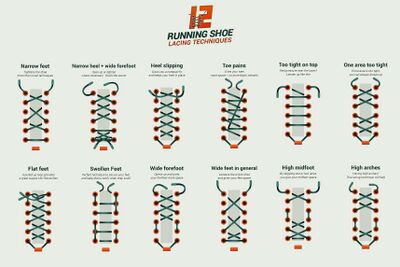
Race versus Training Running Shoes[edit | edit source]
There are a variety of brands and within each brand, there are different types of shoes. Trail, road, track, and a combination of these. It is important to note if the runner, in particular road runners, likes to use a racing shoe and a training shoe. In general, the racing shoe is lighter – so the overall weight of the shoe is less. Its material, particularly the cushioning, is made of extremely good material, but it may not last long due to impact, so these shoes have a shorter run life. Training shoes may be more cushioned and possibly more stable – longer time in the shoe for comfort and longevity.[3]
Different Brands[edit | edit source]
Different brands may be known for specific aspects of a shoe. Some may have a narrower fit while other brands may offer different toe box sizes. Ultimately, if the runner comes with a specific brand and it works for them, don’t change it unless necessary. Look at An Introduction to Understanding Your Runner and Subjective Assessment of a Runner for more information on how to be specific in analysing the runner and their needs.
Vary Shoes[edit | edit source]
If possible, it is recommended that a runner has two pairs of shoes that they can swap between while training. It can even be the same make, worn at different times. This allows the runner's feet to experience a different feel and adapt to this, rather than being in the same shoe all the time. Malisoux et al.[35] showed that runners who use more than one pair of running shoes at the same time had a lower risk of running-related injuries. It is hypothesised that alternating between running shoes induces a variation in the physical load applied to the musculoskeletal system.[35]
Ensure that you recommend the shoe that suits the runner's needs, abilities and terrain, and NOT the looks!
Resources[edit | edit source]
References[edit | edit source]
- ↑ Andreyo E, Unverzagt C, Schoenfeld BJ. Influence of Minimalist Footwear on Running Performance and Injury. Strength and Conditioning Journal. 2022 Jun 26;44(3):107-16.
- ↑ 2.0 2.1 2.2 Nigg BM, Baltich J, Hoerzer S, Enders H. Running shoes and running injuries: mythbusting and a proposal for two new paradigms:‘preferred movement path’ and ‘comfort filter’. British journal of sports medicine. 2015 Oct 1;49(20):1290-4
- ↑ 3.0 3.1 3.2 3.3 3.4 Nunes, D. Shoe Analysis-Shoe Anatomy Course. Plus. 2021
- ↑ Vercruyssen F, Tartaruga M, Horvais N, Brisswalter J. Effects of footwear and fatigue on running economy and biomechanics in trail runners. Med Sci Sports Exerc. 2016 Oct 1;48(10):1976-84
- ↑ Cheung RT, Ng GY. Influence of different footwear on force of landing during running. Phys Ther. 2008;88(5):620-8.
- ↑ Wakeling JM, Pascual SA, Nigg BM. Altering muscle activity in the lower extremities by running with different shoes. Medicine and science in sports and exercise. 2002 Sep 10;34(9):1529-32
- ↑ 7.0 7.1 Wang IL, Graham RB, Bourdon EJ, Chen YM, Gu CY, Wang LI. Biomechanical analysis of running foot strike in shoes of different mass. Journal of sports science & medicine. 2020 Mar;19(1):130
- ↑ Hoitz F, Vienneau J, Nigg BM. Influence of running shoes on muscle activity. PloS one. 2020 Oct 7;15(10):e0239852.
- ↑ REI. What's the difference between trail and road shoes. Available from https://www.youtube.com/watch?v=M_muUYjoVcQ. (last accessed 12 October 2021)
- ↑ Vincent HK, Vincent KR. Considerations in the Selection of a Running Shoe. InClinical Care of the Runner 2020 Jan 1 (pp. 95-99). Elsevier.
- ↑ Average Running PT. Running shoe features: Part 1. Stack Height in Running Shoes. Available from https://www.youtube.com/watch?v=H-BeMkQC-Xg. (last accessed 12 October 2021)
- ↑ RunRepeat.com. The Ultimate Guide to Heel to Toe Drop. Available from https://www.youtube.com/watch?v=Azng4C0PGnM&t=156s. (last accessed 13 October 2021)
- ↑ Lucky Feet Shoes. 3 types of Running Shoes- Motion Control, Stability & Neutral. Available from https://www.youtube.com/watch?v=RppddH-hBz4. (last accessed 13 October 2021)
- ↑ Jafarnezhadgero A, Alavi-Mehr SM, Granacher U. Effects of anti-pronation shoes on lower limb kinematics and kinetics in female runners with pronated feet: The role of physical fatigue. PloS one. 2019 May 14;14(5):e0216818.
- ↑ Lilley K, Stiles V, Dixon S. The influence of design variations in footwear medial-lateral support on the running biomechanics of older female runners. Proceedings of the Institution of Mechanical Engineers, Part P: Journal of Sports Engineering and Technology. 2021 Jan 14:1754337120984619.
- ↑ Nigg B, Behling AV, Hamill J. Foot pronation. Footwear Science. 2019 Sep 2;11(3):131-4.
- ↑ 17.0 17.1 17.2 Nike.com. What's the Difference Between Stability and Motion Control Running Shoes? Available from https://www.nike.com/za/a/stability-vs-motion-control-running-shoes (accessed 2 November 2021)
- ↑ Running Physio. Are motion control shoes the answer for pronation related injuries? Available from https://www.youtube.com/watch?v=IKfHtVbkgLk. (last accessed 13 October 2021)
- ↑ RunRepeat.com.Flat feet lacing technique by RunRepeat.com. Available from https://www.youtube.com/watch?v=S4mwjpFOjJc&list=PLL-rh1VZDnMTUPkEqMx1BRkmcA1yaA7Vw&index=1. (last accessed 13 October 2021)
- ↑ RunRepeat.com. Heel slipping lacing technique by RunRepeat.com. Available from https://www.youtube.com/watch?v=npJpcWuNXeg&list=PLL-rh1VZDnMTUPkEqMx1BRkmcA1yaA7Vw&index=2. (last accessed 13 October 2021)
- ↑ RunRepeat.com. High arches lacing technique by RunRepeat.com. Available from https://www.youtube.com/watch?v=3exKpxPAwZM&list=PLL-rh1VZDnMTUPkEqMx1BRkmcA1yaA7Vw&index=3. (last accessed 13 October 2021)
- ↑ RunRepeat.com. High midfoot lacing technique by RunRepeat.com. Available from https://www.youtube.com/watch?v=hGEG8g0CGCs&list=PLL-rh1VZDnMTUPkEqMx1BRkmcA1yaA7Vw&index=4. (last accessed 13 October 2021)
- ↑ RunRepeat.com. Narrow heel + wide forefoot lacing technique by RunRepeat.com Available from https://www.youtube.com/watch?v=KBCrwNgziyE&list=PLL-rh1VZDnMTUPkEqMx1BRkmcA1yaA7Vw&index=5. (last accessed 13 October 2021)
- ↑ RunRepeat.com. Narrow feet lacing technique by RunRepeat.com. Available from https://www.youtube.com/watch?v=TEZ1g4vfzsU&list=PLL-rh1VZDnMTUPkEqMx1BRkmcA1yaA7Vw&index=6. (last accessed 13 October 2021)
- ↑ RunRepeat.com. One area too tight lacing technique by RunRepeat.com. Available from https://www.youtube.com/watch?v=hjWtGXhaKZg&list=PLL-rh1VZDnMTUPkEqMx1BRkmcA1yaA7Vw&index=7. (last accessed 13 October 2021)
- ↑ RunRepeat.com. One handed lacing technique by RunRepeat.com. Available from https://www.youtube.com/watch?v=ulipu3p3KLI&list=PLL-rh1VZDnMTUPkEqMx1BRkmcA1yaA7Vw&index=8. (last accessed 13 October 2021)
- ↑ RunRepeat.com. Swollen feet lacing technique by RunRepeat.com. Available from https://www.youtube.com/watch?v=LSps4kSkdxE&list=PLL-rh1VZDnMTUPkEqMx1BRkmcA1yaA7Vw&index=9. (last accessed 13 October 2021)
- ↑ RunRepeat.com. Toe pains lacing technique by RunRepeat.com. Available from https://www.youtube.com/watch?v=mmsv238FFs0&list=PLL-rh1VZDnMTUPkEqMx1BRkmcA1yaA7Vw&index=10. (last accessed 13 October 2021)
- ↑ RunRepeat.com. Too tight on top lacing technique by RunRepeat.com. Available from https://www.youtube.com/watch?v=Gj_9zCu2mBM&list=PLL-rh1VZDnMTUPkEqMx1BRkmcA1yaA7Vw&index=11. (last accessed 13 October 2021)
- ↑ RunRepeat.com. Wide feet in general lacing technique by RunRepeat.com. Available from https://www.youtube.com/watch?v=zmMnJ_FMwBY&list=PLL-rh1VZDnMTUPkEqMx1BRkmcA1yaA7Vw&index=12. (last accessed 13 October 2021)
- ↑ RunRepeat.com. Wide forefoot lacing technique by RunRepeat.com. Available from https://www.youtube.com/watch?v=MoV_RYHMXjk&list=PLL-rh1VZDnMTUPkEqMx1BRkmcA1yaA7Vw&index=13. (last accessed 13 October 2021)
- ↑ RunRepeat.com. The Ian knot by RunRepeat.com. Available from https://www.youtube.com/watch?v=pKRZDHbLQIg&list=PLL-rh1VZDnMTUPkEqMx1BRkmcA1yaA7Vw&index=14. (last accessed 13 October 2021)
- ↑ RunRepeat.com. Ian's secure shoelace knot by RunRepeat.com. Available from https://www.youtube.com/watch?v=eFjmnie5BZw&list=PLL-rh1VZDnMTUPkEqMx1BRkmcA1yaA7Vw&index=15. (last accessed 13 October 2021)
- ↑ RunRepeat.com. Surgeon's Shoelace Knot by RunRepeat.com. Available from https://www.youtube.com/watch?v=ujDOEZOdesc&list=PLL-rh1VZDnMTUPkEqMx1BRkmcA1yaA7Vw&index=16. (last accessed 13 October 2021)
- ↑ 35.0 35.1 Malisoux L, Ramesh J, Mann R, Seil R, Urhausen A, Theisen D. Can parallel use of different running shoes decrease running‐related injury risk?. Scandinavian journal of medicine & science in sports. 2015 Feb;25(1):110-5.
- ↑ Running Physio. How to select running shoes for specific injuries. Available from https://www.youtube.com/watch?v=HjVDLXKYqqw&t=329s. (last accessed 13 October 2021)
